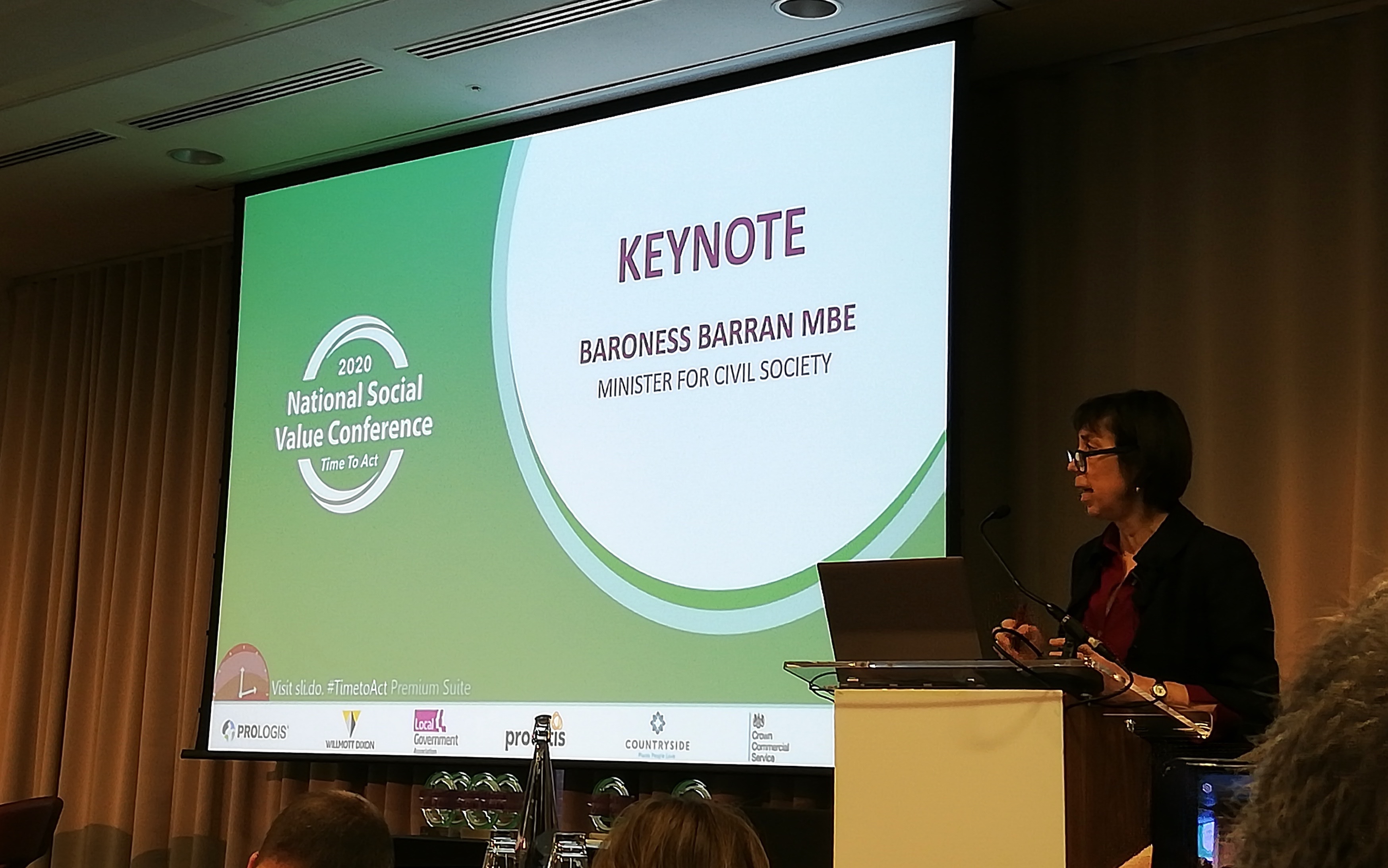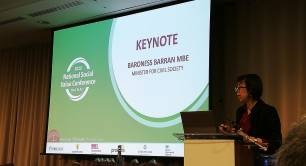Can cheap be cheerful? Four hotly debated questions on social value in public services
Tensions that we don’t talk about, comparing apples with pears, and purchasing decisions we thought were right but shouldn’t have made – procurement bosses and social value gurus get to grips with the big issues of buying for public benefit.
Not long ago, public sector procurement staff “couldn’t describe what social value meant… we couldn’t quantify it”. This was despite the fact that a Social Value Act had existed in the UK since 2012 to require public authorities to consider economic, social and environmental wellbeing in awarding their public services contracts.
But in just over two years, “we’ve come a hell of a long way”.
So said Darren Knowd, the procurement boss of Durham County Council – and chair of a national taskforce on social value – as he addressed last month’s National Social Value Conference in London.
The ‘two years’ refers to the time since the Local Government Association – the national membership body for councils in England – launched something called TOMs (Themes, Outcomes and Measures), a national framework created in partnership with the Social Value Portal to help councils measure the value they are achieving through implementing the Social Value Act.
The rising interest in the topic was reflected at this year's conference, which attracted some 400 people from around the country – many of them with ‘social value’ not only on their to-do list, but also in their job titles.
Terry Collins, CEO at Durham County Council, said the notion of social value “has changed people’s perceptions of procurement… in my council, it’s now generally viewed as strategically adding value to support the achieving of our key business outcomes”. His council won a Cabinet Office award for social value leadership in 2016.
But if proponents of social value are positive about progress to date, there are many unanswered – or at least hotly debated – questions. Here are the big ones Pioneers Post heard.
1. Can social value be reduced to numbers?
Social Value Portal CEO Guy Battle said the breakthrough after 25 years of “banging my head against the wall” was thanks to finally putting numbers on social value. “Whether that’s a social return on investment [SROI] analysis or it’s a TOMs analysis, in a way it doesn’t matter,” he said. The ability to point to, say, an additional 20% worth of value achieved through a contract, had made it hard to ignore.
Procurement officials echoed this. Collins said the TOMs framework, which helps assess the impact of an activity by applying proxy financial values, was an “invaluable tool” to explain and quantify social value.
Filip Leonard, head of procurement and supply chain at Sheffield City Council, said it had been “really helpful” in conversations with commissioners and suppliers – and, in his own assessment, helped the council go from “pretty rubbish to not bad”.
Elected officials sometimes want contractors to achieve social value in a particular area, because it fits in with their campaign promises
But, while proponents of social value calculation tools agree that numbers don’t tell the full story, others are more sceptical.
Liz Riley, a social value consultant, told Pioneers Post she was wary of an overreliance on tools that are sold “as if they’re a solution to the problem” yet are “disassociated from people”. Using something like the TOMs to generate numbers, she added, risked “losing the granularity of how you produce value and who you produce it for”.
Jennifer Wallace, head of policy at Carnegie UK Trust, suggested the disconnect from the human factor was a wider problem. “We have no way in procurement of maintaining relationships between service users and providers, even though we know that relationships really matter, particularly for vulnerable people… the amount of work needed to put the human side back into our public services is significant.”
Northumbria University’s Deborah Harrison – who presented research on creating better work through procurement – pointed to an “underlying cynicism” that social value may be “reduced to a numbers game”, one which bigger suppliers would probably win. For example, they could offer many more apprenticeships than a smaller competitor could, even if those placements weren’t great quality, or if trainees spent years jumping from one apprenticeship to the next.

Above: In a keynote speech at the National Social Value Conference, minister for civil society Diana Barran acknowledged that the social impact achieved through the government’s £49bn spending was not up to scratch.
2. Apples vs pears and other moral dilemmas: how do commissioners decide?
What does a procurement official do when faced with two equal bids, one proposing to reduce carbon emissions, and one offering to create new jobs?
Ben Carpenter, CEO at Social Value UK – the membership body for social value practitioners, which co-hosted the conference along with Social Value Portal – said trade-offs were inevitable.
“Every time we make a decision we are making value judgements – accounting for social value helps make those decisions more transparent and when the values are informed by stakeholders’ views it makes them more likely to be the right decisions.”
And tools like the TOMs are supposed to help with exactly this kind of dilemma, by calculating an overall financial value of each. Decision-makers can then choose based on non-numerical factors, according to their own priority – though, as Battle said, “you’d better have a really good reason, that you've published ahead of time, because otherwise you’ll get challenged”.
‘There are tensions there that we don’t talk about’
But it’s clear that many are still worried about the dilemmas. One official from a health body wondered how they might choose between a provider of medical equipment that is more expensive, but also promises additional social value, versus another that does not but is cheaper and therefore means buying more units and could therefore save more lives.
And Harrison highlighted another conflict. Many see social value as an opportunity to support local businesses – but what if a much bigger national company is able to pay higher wages and better benefits? “There are tensions there that we don’t talk about,” she said.
3. How do we know we’re measuring what matters?
Carpenter praised the field’s growing momentum but called on attendees to be “conscious of those that are not in the room… if we are a movement we need to be inclusive”.
Being more inclusive and listening to people whose lives are affected would help address another enduring question: how do we know we’re measuring what actually matters to the people we’re trying to help? As Durham’s Knowd put it: “Every one of us will have bought the wrong kind of social value because that’s what we thought people wanted.” One delegate even said that public bodies headed by elected officials sometimes want contractors to achieve social value in a particular area, because it fits in with their campaign promises – not because that’s the area of impact most needed or wanted by the community.
‘Every one of us will have bought the wrong kind of social value because that’s what we thought people wanted’
Involving stakeholders is the first principle of the SROI approach, first developed 13 years ago, and Carpenter says that “amplifying the voices of those with no, or little power, is the key to accounting for social value”. But Riley, an experienced SROI practitioner, said it was “perfectly possible” to use tools like the TOMs without consulting stakeholders; if you don’t get that right, “you can't get anything else right”.
There are some examples of bringing communities into the process. Social Value Portal’s Anna McChesney-Gordon described working with one client, a property developer, to create an action plan for social value over the multiple years it would be building in a small town. Decisions about what goes into that plan came partly from her own research into issues affecting the local area, but also from face-to-face meetings with people in the village hall.
4. What’s next for central government procurement?
The UK government was supposed to issue a response to its open consultation on updating the Social Value Act back in September. Brexit and the general election have delayed this, and in her speech charities minister Diana Barran said only that it was coming “in due course”.
But, also speaking at last month's conference, the Cabinet Office’s chief commercial officer Gareth Rhys Williams did hint at what to expect.
The main message from consultation responses, he said, had been to “keep it simple” and avoid accidentally weighting the competition in favour of large companies. “That would be an unexpected policy hole to fall into.”
The procurement boss also said that the recent change in language – central government officials must now “account for” (not just “consider”) social value in buying decisions – was “about as binary a switch” as possible in the civil service, and revealed that up to 10,000 staff are getting training in how to apply these new principles.
Recent pledges to “level up” the economy – bringing poorer regions up to the same level as the wealthier south-east – could help drive support for social value considerations. “I think everyone has rumbled that using social value criteria in our procurements will really drive that agenda,” said Rhys Williams. “So this isn't going away… this is part of the future.”
Thanks for reading our stories. As somebody working in the impact economy, you'll know that producing quality work doesn't come free. We rely on paid subscriptions and partnerships to sustain our purpose-led journalism – so if you think it's worth having an independent, specialist media platform to share your news, insight and debate across the globe, please consider subscribing. You'll also be buying social: Pioneers Post is a social enterprise itself, reinvesting all profits to help you do good business, better.




